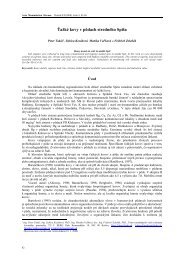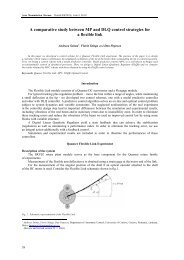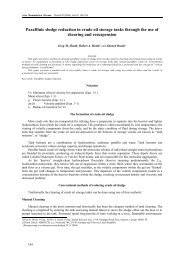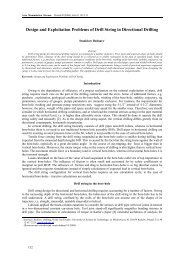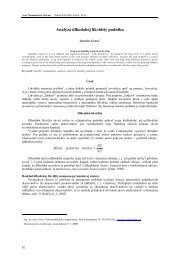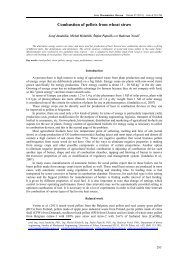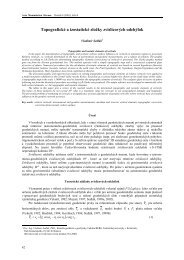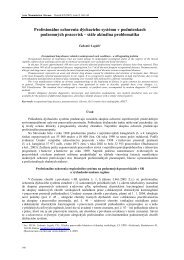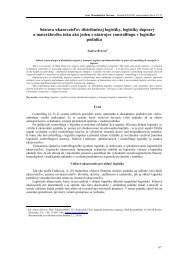Procedure for Arranging Centralizers - Acta Montanistica Slovaca
Procedure for Arranging Centralizers - Acta Montanistica Slovaca
Procedure for Arranging Centralizers - Acta Montanistica Slovaca
You also want an ePaper? Increase the reach of your titles
YUMPU automatically turns print PDFs into web optimized ePapers that Google loves.
<strong>Acta</strong> <strong>Montanistica</strong> <strong>Slovaca</strong> Ročník 3 (1998), 1, 24-28<br />
<strong>Procedure</strong> <strong>for</strong> <strong>Arranging</strong> <strong>Centralizers</strong><br />
in Casing String Run into Directional Wells<br />
Andrzej Gonet 1 , Stanislaw Stryczek 1 and Ján Pinka 2<br />
Postup pre rozmiestnenie centrátorov na pažnicovej kolóne určenej pre zapaženie<br />
v horizontálných vrtoch<br />
Centrátory patria medzi najdôležitejšie elementárne častí technického vybavenia<br />
pažnicových kolón. Centrické umiestenie pažnicovej kolóny, obzvlášť v horizontálnom vrte, je<br />
jednou z podmienok kvalitnej cementácie vrtu. Centrátory sú prostriedkami pre centráciu<br />
pažnicovej kolóny a umožňujú rovnomerné zaplnenie medzikružia vrtu cementovou suspenziou.<br />
Tento článok pojednáva o postupe metódy pre rozmiestenie minimálneho potrebného počtu<br />
centrátorov na pažnicovej kolóne, ktorá je určená pre zapaženie horizontálneho vrtu.<br />
Key words: Centralizer, Casing String, Directional Well, Three - Dimensional Space, Borehole<br />
Well.<br />
Introduction<br />
<strong>Centralizers</strong> (Weather<strong>for</strong>d, 1994) are one of the most important elementary parts of technical<br />
equipment of a casing string. Currently throughout the world more and more directional holes are<br />
being drilled, which are often located in three-dimensional space. Generally it can be said the more<br />
complicated the hole axis, the more difficult it is to maintain coaxial placement of a casing string run<br />
into such a hole. <strong>Centralizers</strong> play a significant role in limiting a number of columns of a casing string<br />
run to a hole and in minimizing the clearances in the hole (Lubinski, 1987; Wisniowski et.al., 1995).<br />
Maintaining the right clearance between the wall of the hole and the casing columns has critical impact<br />
on the quality of its sealing.<br />
Placing too many centralizers on the casing string seriously impedes running pipes into the<br />
hole and unnecessarily increases the overall cost of the hole. On the other hand too few centralizers<br />
on the casing string will not ensure proper sealing of the hole. For this reason the aim is to develop<br />
a kind of method <strong>for</strong> placing centralizers on a casing string which would take into account the spatial<br />
position of the hole as well as the load of the casing string with a minimum number of centralizers.<br />
An attempt at viewing this problem in such a light is presented in this article.<br />
At the present time when sealing of casing strings is carried out, their construction as well as<br />
recipes <strong>for</strong> sealing slurries are very carefully selected, taking into consideration such factors as the<br />
influence of temperature, pressure and time on technological parameters. The field equipment used to<br />
prepare and pump sealing slurries into the hole is continually being improved.<br />
The Casing String Load<br />
The casing string run into the hole is subject to various loads, the most important of which are<br />
axial tension, compressing, bending and torison (Gonet, 1997). <strong>Centralizers</strong> located on the casing<br />
torsion-string mediate in the above-mentioned loads and are places of contact with the holewall. The<br />
system of Kirchhoff equations was chosen <strong>for</strong> this discussion on the casing string load with<br />
centralizers run into holes.<br />
Given the assumptions presumed in this study (Gonet, 1997), the unit stresses acting<br />
on a centralizer along tangent, normal and binormal axes of the hole (Fig. 1) amount to:<br />
N =−ks EI −qcosα [ N/m] (1)<br />
1<br />
2<br />
1 Faculty of Drilling, Oil and Gas, Unvezity of Mining and Metallurgy, Cracow, Poland<br />
2 Katedra mechanizácie, dopravy a vŕtania, F BERG, Technická univerzita, 043 84 Košice, Park Komenského 14, Slovakia<br />
(Recenzovali: Prof.Ing. Ján Fabian, CSc. a Ing. Víťazoslav Krúpa, CSc. Revidovaná verzia doručená 15.2.1998)<br />
25
Gonet, Stryczek and Pinka: <strong>Procedure</strong> <strong>for</strong> <strong>Arranging</strong> <strong>Centralizers</strong> in Casing String Run into Directional Wells<br />
N = ks EI −ksM −kT −qsinα [ N/m] (2)<br />
2<br />
2<br />
1 1<br />
where:<br />
N<br />
3<br />
3<br />
= s EI [ N/m] (3)<br />
N1, N2, N3 - unit stress of casing along axes x 1<br />
, x 2<br />
, x 3<br />
respectively [ N/m] ,<br />
T1<br />
- tangent tensile <strong>for</strong>ce of the casing [ N],<br />
E - Young’s modulus of the casing material [ N/m 2 ],<br />
I - axial moment of inertia [m 4 ] ,<br />
q - unit weight of the casing immersed in fluid [ N/m] ,<br />
M - momentum acting along axis x [ N .m] ,<br />
1 1<br />
α - deviation angle of the hole's axis [ o ],<br />
k<br />
- curvature of the casing's axis in the hole [1/m],<br />
s<br />
- torsion of the casing's axis in the hole [1/m].<br />
The origin of the coordinate system (Fig. 1) is always located at the casing string's axis<br />
in a place where the next lower centralizer is situated. This means that the first centralizer is located<br />
by counting from the bottom of the casing string. The next ones are counted in succession and<br />
together with an increase in the number of centralizers, the coordinate's system is shifted upward in<br />
such a way that its beginning is always at the lower centralizer whose placement was last designated.<br />
The elementary length of the casing string is always matched to the distance between neighboring<br />
centralizers. The curvature and torsion of the elementary arc <strong>for</strong> the axis of the casing string run into<br />
the hole are approximated on the basis of geophysical measurements made earlier in a given hole.<br />
Depending on the measuring equipment used, the spatial placement of the hole's axis may be<br />
determined <strong>for</strong> example by the tangent, trapezoidal or Mercury methods (Walstrom, 1972).<br />
When the type and location of the centralizers on the casing string are properly chosen, the<br />
axes of the hole and casing string are close to each other. There<strong>for</strong>e it can be assumed, with very little<br />
error, that the curvature and torsion on the elementary arc are constant. The momenta acting on the<br />
casing string are dependent upon the casing string's curvature and torsion as well as upon the way it<br />
is run into the hole.<br />
Unit resultant <strong>for</strong>ce acting on a centralizer<br />
is equal to the the diagonal of a cuboid<br />
constructed on three sides suited to the unit<br />
stresses N1, N2, N3 respectively. However<br />
the total resultant <strong>for</strong>ce N d<br />
acting on a centralizer<br />
is a product of the unit stress and<br />
length L c<br />
of a casing between neighboring<br />
centralizers, that is:<br />
Fig. 1. The unit stresses acting on a centralizer<br />
located on a casing string in the hole.<br />
26
<strong>Acta</strong> <strong>Montanistica</strong> <strong>Slovaca</strong> Ročník 3 (1998), 1, 24-28<br />
N = L [ N + N + N<br />
d<br />
c<br />
2<br />
1<br />
2<br />
2<br />
2 05 .<br />
3<br />
] [N] (4)<br />
Each type of centralizer has its own characteristics (API Specification, 1990; Weather<strong>for</strong>d<br />
1994), from which an permissible load, which will be called N c<br />
[N], is chosen earlier. Given the<br />
assumption that the stress on a centralizer, whose distance is defined, does not exceed the<br />
permissible stress, the maximum distance <strong>for</strong> placing the successive centralizer is calculated as<br />
follows:<br />
L<br />
c<br />
N<br />
c<br />
= [( −<br />
2<br />
ks EI − q cos )<br />
2 + (<br />
2<br />
α ks EI − ksM − kT − q sin α ) + ( s EI ) ]<br />
1 1<br />
2 2 2 0.5<br />
[m] (5)<br />
Limitations<br />
A casing string run into a hole undergoes fluctuation of stress. <strong>Centralizers</strong> which are<br />
improperly located can become damaged during the run and become the cause of complications. For<br />
this reason, the entire methodology of locating centralizers on a casing string consists of the part<br />
suited to the goal of ultimately placing of the casing in a hole as well as the part with limitations<br />
resulting from their translation in a hole. This is particularly significant in these intervals of a hole in<br />
which the largest curvatures and torsions of the casing occur. Verification of the centralizers'<br />
placement is based on calculating the quotient of the maximum translation of the casing axis and the<br />
radial clearance given by the following <strong>for</strong>mula:<br />
S =<br />
Ri − Rz − Ci<br />
− Di<br />
R − R<br />
i<br />
z<br />
[dimensionless] (6)<br />
where:<br />
R i<br />
R z<br />
C i<br />
D i<br />
- radius of the hole at the i-th intersection [mm],<br />
- outer radius of the casing string [mm],<br />
- bending of a centralizer due to a side-load at i-th intersection [mm],<br />
- maximum bending of the casing at i-th intersection [mm].<br />
If the quotient defined by the equation (6) is not less than 0,67 in the tested intervals of casing<br />
run into the hole, then the distances between centralizers calculated using equation (5) are not subject<br />
to change (Fig. 2). Otherwise the distance between these centralizers should be decreased enough so<br />
that the stand-off attains a value of 0,67.<br />
Fig. 2. Centralization of centralizers casing string in directional well.<br />
27
Gonet, Stryczek and Pinka: <strong>Procedure</strong> <strong>for</strong> <strong>Arranging</strong> <strong>Centralizers</strong> in Casing String Run into Directional Wells<br />
The above procedure is repeated <strong>for</strong> all centralizers starting with the one situated lowest on<br />
the casing string run into a hole.<br />
Conclusions<br />
1. The casing string run into a hole is subject to various loads depending on:<br />
- the unit weight of the casing string,<br />
- the stiffness of the casing string,<br />
- the technology of running the casing string run into a hole,<br />
- the spatial placement of the hole's axis.<br />
2. For a hole calculated in three-dimensional space, the distance between successive centralizers is<br />
calculated according to the equation (5). This distance depends on the permissible stress resulting<br />
from the technical characteristics of a given type of a centralizer, the placement of the hole’s axis,<br />
the local load of the casing and their parameters.<br />
3. The ultimate placement of centralizers in the casing string should be determined by verifying along<br />
the trajectory of the hole’s axis the condition (6) stating that the quotient of the greatest clearance<br />
of the casing’s axis and of the radial clearance does not exceed the permissible value if 0,67. As<br />
the rheology parameters of sealing slurries and sealing technologies improve, this value should<br />
decrease.<br />
The support of the State Committee <strong>for</strong> Scientific Research is fully acknowledged.<br />
Study number: 249.620.01 at the Department of Drilling, Oil and<br />
Gas of the University of Mining and Metallurgy in Cracow, Poland.<br />
References<br />
API Specification 10D <strong>for</strong> Bow-Spring Casing <strong>Centralizers</strong>, 1990.<br />
Gonet, A.: A Method of Placing <strong>Centralizers</strong> on Casings. IX. International Conference, Kosice,<br />
September 2-4, 1997.<br />
Lubinski, A.: Developments in Petroleum Engineering. Gulf, Houston 1987.<br />
Mechanical Cementing Products. Weather<strong>for</strong>d, Houston 1994.<br />
Walstrom, J.E. et al.: A Comparison of Various Directional Survey Models and an Approach to Modell<br />
Error Analysis. Journal of Petroleum Technology, August, 1972.<br />
Wisniowski, R., Gonet, A., & Capik M.: Numerical Aided Decision Making Regarding <strong>Centralizers</strong>’<br />
Placement on Casing String. International Conference on Applied Mathematical Methods in<br />
Science and Technology, Cracow, June 20-21, 1995.<br />
Strnište, K. & Pinka, J.: Drilling Data Handbook. Olympia Košice, 1993.<br />
28



